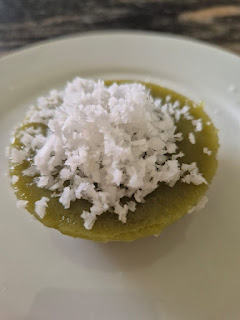Kuih lompang pandan is a traditional Malay kuih which is made from rice flour, tapioca flour and pandan juice. It differs from kuih lompang gula Melaka in terms of colour; the latter is brown in colour from the gula Melaka while kuih lompang pandan is green from the pandan juice. The batter is steamed in individual small round moulds. A dimple is formed on top of the kuih and coconut flakes are added on top before it is eaten.
Ingredients:
- Coconut flakes from half of a coconut (without brown skin)
- 1/4 tsp salt
- 120 g sugar (140 g for a sweeter kuih)
- 360 ml water
- 6 pandan leaves for a pastel green or 8 leaves for a darker kuih
- 120 g rice flour
- 60 g tapioca flour (or 50 g tapioca flour plus 10 g mung bean flour)
Method:
- Steam coconut flakes with salt.
- Leave aside.
- Wash and cut pandan leaves into small pieces.
- Blend pandan leaves with water.
- Sieve to obtain pandan juice.
- Add sugar pandan juice. Stir till all sugar is dissolved.
- Add water to a steamer and turn on the fire.
- Let the water boil.
- Oil 12 porcelain or stainless steel moulds.
- Put them into the steamer to heat them up.
- Mix rice flour and tapioca flour (or tapioca flour and mung bean flour) in a mixing bowl.
- Add the pandan juice to the flours.
- Stir till there are no lumps.
- Transfer the flour mixture to a pot.
- Place the pot over very low fire.
- Keep on stirring the flour mixture until it SLIGHTLY thickens.
- Sieve the mixture into a pouring jug.
- Pour the mixture into the prepared porcelain or stainless steel moulds.
- Steam the batter for 25 minutes or till it is cooked.
- Remove the kuih onto a plate.
- Spoon the coconut flakes onto the top of the kuih.
- Serve.




































